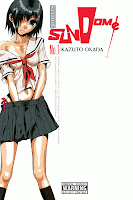Artist: Gurihiru
Letterer: Michael Heisler
Avatar: The Last Airbender created by Michael Dante DiMartino and Bryan Konietzko
Go to my reviews of parts one and two.
[Warning: Spoilers ahead]
The Promise occupies the gray area between The Last Airbender and Legend of Korra. As it stands, it often feels like an additional season of the the former. And it contains plenty of the requisite fanservice. But whereas the TV series tended to meander a lot, the graphic novel is far more succinct, often to the point of feeling truncated at times. Supporting characters don't always receive equal attention. And just as the narrative's primary conflict is quickly introduced, it's just as quickly expedited in the last volume.
The common theme found in the two TV serials is that of diversity. The Last Airbender had a simple fairy tale premise that supported the idea that diversity was preserved through the separation of the four "nations". Not that this principle was strictly observed when the hero travelled the world with a multinational gaggle in tow. But Aang did treat the territorial boundaries between them as inviolable, and the basis for rejecting the Fire Nation's conquest of the Earth Kingdom. Legend of Korra takes place in a historically grounded setting where boundaries, both external and internal, are more realistically portrayed as fluid. It's the task of The Promise to link the two in such a way that the fairy tale, with its quasi-mythical racial divisions, and the postcolonial adventure, composed of a multicultural pastiche, are seen as belonging to the same timeline. It accomplishes this on the surface level by supplying all kinds of fanservice-friendly filler material foreshadowing the birth of the airbender acolytes, the metalbending police force, the United Republic of Nations, the recorded union of Aang and Katara. But the third volume also does most of the heavy lifting regarding the evolution of the beliefs and philosophies of its youthful cast, particularly that of Avatar Aang and Fire Lord Zuko.
That the strife ultimately revolves around the psychodrama between these two characters should not come as a surprise to fans. What is different is the lack of an obvious archvillain to externalize the narrative's conflict, something both TV serials used as a convenient scapegoat and as a way to bring the issues into stark relief. And without a villain to rally against, it turns out that Aang functions as the role of principal antagonist while the usually impetuous Zuko is proven to actually be on the right side for once. Aang is the rigid traditionalist worried about safeguarding cultural purity, while Zuko is desperately seeking a logical way to avoid an impending second world war between the Fire Nation and the Earth Kingdom. Aang's promise to Zuko, which was given in part one, serves to further raise the stakes by personalizing the dilemma.
| Aang carries out his Avatar-defined duties |
I've felt however from the beginning that this plot point was a weakness of the story. That Aang would even seriously consider offing his good friend Zuko, let alone quickly assenting to carrying out such a grim oath if it ever became necessary, seems less likely than the possibility that he would have actually killed his mortal enemy Fire Lord Ozai in the TV series finale. Not even some mystically-infused dream at the beginning of this volume could convince me otherwise. Didn't Aang already surpass those methods after communing with this guy? So the eventual showdown between the two felt anticlimactic, repetitive, and unoriginal. Another scene that particularly irked me was a conversation where Aang describes the compassion he exhibited throughout the ATLA series as a kind of character "flaw". Coming from him, the statement rings false and the message being conveyed comes across as a little too on-the-nose to me.
In case I've given the wrong impression that this is an introspective work, this volume is packed with more action than the last two parts, with the battle between the Fire Nation and Earth Kingdom armies and the colonists forming its centerpiece. The series unique mixture of hand-to-hand combat and humor is very much still in force, with the trio of Sokka, Toph, and Suki using similarly disruptive guerrilla tactics to what they did in the ATLA finale to very much the same comic effect. Mind you, the juvenile quips don't always work, especially with older readers. One character is reduced to a running joke about how he managed to land a total babe for a girlfriend. That gets old real fast. And there is a downside to cramming so many characters within a graphic novel. Some of them, like Ozai and Mai, simply vanish from the story. Others, like Earth King Kuei and Iroh, make only brief, perfunctory appearances. But the biggest disappointment is how Katara gets transformed from independently minded badass to Aang's supportive girlfriend. I get that she needs to hang out with her beau, but she doesn't get to do anything cool on her own time anymore. Not even to chew out Sokka and Toph for behaving like idiots.
| Kataang wins again! |
But wait! Is that queen bee Azula staging her big comeback? Maybe fans will finally get to see another rematch in the future.


























































